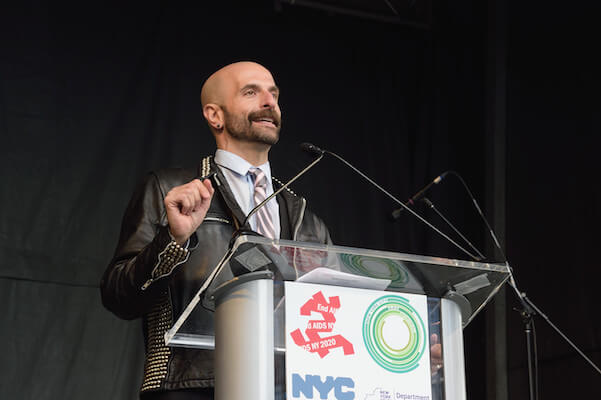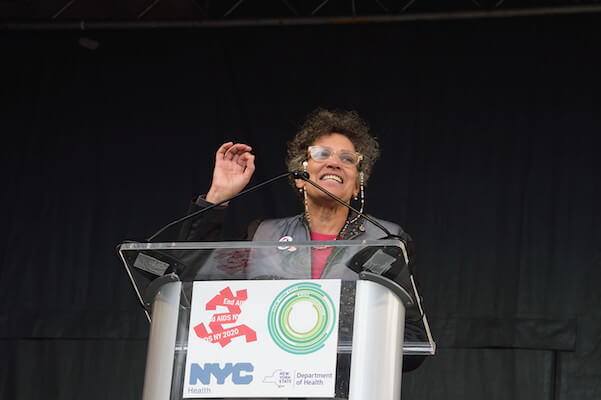A COMMUNITY LETTER | On Sunday, June 29, coinciding with New York City Gay Pride, Governor Andrew Cuomo made history by committing New York State to ending AIDS as an epidemic by 2020.
New York, the epicenter of the nation’s HIV epidemic since the beginning, now becomes the first jurisdiction in the world to launch an effort to end our AIDS epidemic, even without a cure, by stopping deaths from HIV and eliminating new HIV infections.
The governor’s announcement builds on recent scientific findings that early HIV treatment can reduce new transmissions of the virus by 96 percent and that two anti-HIV drugs given together, when taken daily as prevention, can reduce new infections by over 90 percent.
Because getting all HIV-positive New Yorkers into care, with adequate support services, will increase HIV program costs, over the past six months, the state successfully negotiated discounts from several HIV drug manufacturers, comprising 73 percent of the state market. We call on the holdout companies — representing the remaining 27 percent and making important treatments — to expeditiously come to similar agreements.
New York has the people, institutions, resources, and tools needed to end AIDS as an epidemic and Governor Cuomo’s announcement shows the way forward for other jurisdictions around the country and around the world.
In June 2013, a remarkable coalition of over 30 New York organizations, among them LGBT and AIDS groups, asked Governor Cuomo to be as progressive regarding AIDS as he is in other arenas by publicly declaring an end to AIDS in New York by the year 2020 and by appointing a high-level State Task Force to develop the strategic roadmap and plan to get us there. On June 29, Governor Cuomo took a bold step and committed to a State Plan to End AIDS by 2020. We continue to urge him to convene a multi-stakeholder State Task Force to map out the details of the plan — to establish set goals, benchmarks, and outcomes on a timeline between now and 2020 — and then to coordinate and monitor implementation.
The goal is ambitious, but grounded in reality. New York State has always been a leader in the fight against AIDS. We have seen an almost 40 percent decrease in new HIV diagnoses in the last decade, with fewer new infections each year, while nationally there has been no decline in the number of new HIV infections diagnosed each year. Now, the Affordable Care Act (ACA) implementation and New York’s incredibly successful Medicaid reform give us unprecedented momentum, putting more people, especially those at risk, into primary care and freeing up funds for support services vital to HIV treatment adherence.
We also have the science — new testing technologies, new prevention tools like pre-exposure prophylaxis, or PrEP, and post-exposure prophylaxis, or PEP, and highly effective antiretroviral treatments. An HIV-positive person on treatment that renders the virus “undetectable” in the blood is not only healthy but also virtually unable to transmit HIV to others.
With these advancements we can end AIDS if we have the resolve, even while critical research continues toward a cure and a vaccine.
Over the past three decades, we’ve learned that any effective plan to address AIDS requires shared commitment: the political will of government, coordination between state and city health agencies, and the energy and dedication of AIDS activists, doctors, researchers, and service providers.
In addition to the drug-discount negotiations, other breakthroughs over the past year include the affordable housing protection for disabled people with HIV put in place by Governor Cuomo and Mayor de Blasio and new HIV testing laws that will increase our ability to diagnose HIV early and get positive persons into care while they’re still healthy.
Now that Governor Cuomo is throwing his full weight behind this initiative with confidence, we have the political leadership as well as the science, momentum, community support, and social protections required to make the end of AIDS in New York a reality.
It’s not only the right choice, it’s also cost-effective. Our current “stable” epidemic in New York State is expensive — in human lives and public spending — and unsustainable over time. In New York, 130,000 people live with HIV and 3,000 new HIV infections occur annually. These 3,000 new infections add at least $36 million in HIV medicine costs alone every year.
Every averted HIV infection saves the state over $400,000 in lifetime medical costs. Current HIV prevention and care saves the state $1 billion every year through improved health outcomes and prevented infections. The State Plan to End AIDS will more than double those savings, freeing funds that could be re-allocated to address other health issues.
We have work to do. Although new infections are dropping in almost every other demographic, in New York State, HIV is rising dramatically among young men who have sex with men and transgender women. Our governor led the way nationally by redesigning Medicaid to improve health outcomes and save the state $8 billion. Applying the latest scientific evidence in the context of universal health coverage New York State can also show the way for all to end AIDS.
“We have won when we’re one”was NYC Pride 2014’s theme, the idea being that the marriage equality fight isn’t over until the LGBT community worldwide enjoys its protections.That theme also echoes a longstanding theme of the AIDS movement: “The AIDS epidemic isn't over until it's over for everyone.”
Since Governor Cuomo successfully led New York to marriage equality, more than a dozen other states have followed suit. By launching New York State on a sustainable path to ending AIDS, Governor Cuomo once again lays down a challenge for other states to follow.
Governor Cuomo has chosen to make history by committing the full resources of New York State to ending AIDS in the next decade. We salute him for his leadership, we look forward to his appointment of a State Task Force to create a blueprint and implementation strategies for the plan, and we vow to work with him and all New Yorkers in making this commitment a reality.
Perry Junjulas, Executive Director And person living with AIDS The Albany Damien Center
Michele McClave, Executive Director AIDS Council of Northeastern New York
Benjamin Bashein, Acting Executive Director ACRIA
Doug Wirth, President/ CEO Amida Care
Regina R. Quattrochi, CEO Bailey House, Inc.
Robert Cordero, President and Chief Program Officer BOOM!Health
Erin Drinkwater, Executive Director Brooklyn Community Pride Center
Diane Arneth, President/ CEO Community Health Action of Staten Island
Denis Nash, Ph.D., Executive Officer Doctor of Public Health Programs CUNY School of Public Health and Hunter College
Jennifer Jones-Austin, CEO/ Executive Director Federation of Protestant Welfare Agencies
Kelsey Louie, CEO GMHC
Steven C. Bussey, CEO Harlem United Community AIDS Center, Inc.
Barbara Zeller, MD, Chief Clinical Officer HELP/ PSI
Charles King, President/ CEO Housing Works, Inc.
Jeffrey Reynolds, Ph.D., Executive Director Long Island Council on Alcoholism and Drug Dependence (LICADD)
William Moran-Berberena, Executive Director MCCNY Charities, Inc.
Sharon Stapel, Executive Director New York City Anti-Violence Project
Carolina Lopez, Executive Director New York Harm Reduction Educators
Peter Gordon, MD, Medical Director Comprehensive Health Program, New York Presbyterian/ Columbia
Virginia Shubert, Principal Shubert Botein Policy Associates
Robert Maher, Executive Director TOUCH –– Together Our Unity Can Heal, Inc.
Mark Harrington, Executive Director Treatment Action Group (TAG)
Emma DeVito, President/ CEO VillageCare
Sean Barry, Executive Director VOCAL-NY
































